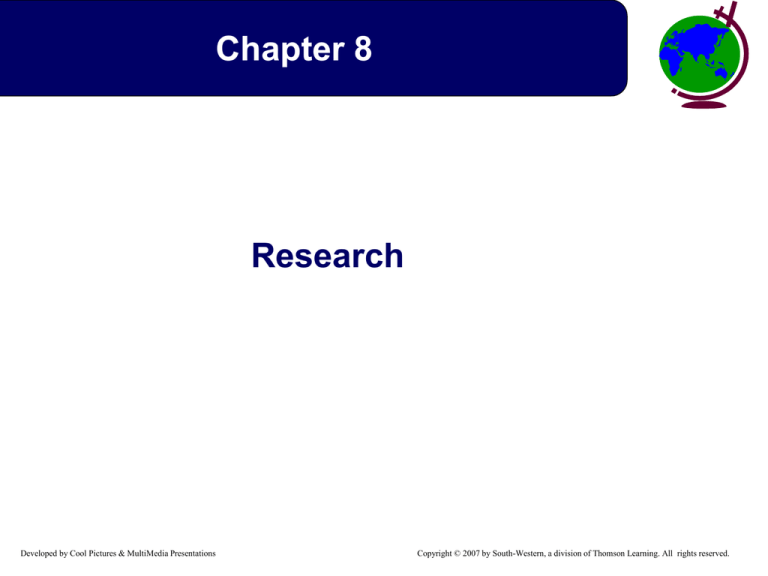
Chapter 8
Research
Developed by Cool Pictures & MultiMedia Presentations
Copyright © 2007 by South-Western, a division of Thomson Learning. All rights reserved.
Defining the Issue
• What is marketing research?
– Traditional view
• “the function that links the consumer, customer, and
public to the marketer through information.”
– Redefined view
• “systematic and objective identification of
information, collection, analysis and dissemination of
information for the purpose of improving decision
making related to the identification and solution of
problems and opportunities in marketing.”
Developed by Cool Pictures & MultiMedia Presentations
Copyright © 2007 by South-Western, a division of Thomson Learning. All rights reserved.
International versus Domestic
Research
• Similar but different
– International research involves the use of similar
tools and techniques as in domestic research, but
the market environments differ.
• The primary differences
– New parameters
– New environments
– Number of factors involved
– Broader definition of competition
Developed by Cool Pictures & MultiMedia Presentations
Copyright © 2007 by South-Western, a division of Thomson Learning. All rights reserved.
The Need for Research
• Reasons that firms may be reluctant to view international
research as important:
– Lack of sensitivity to differences in consumer tastes
and preferences.
– Limited appreciation for the different marketing
environments abroad.
– Lack of familiarity with national and international data
sources and the inability to use them.
– Actual but limited business experience in a country or
with a specific firm may be used as a substitute for
organized research.
Developed by Cool Pictures & MultiMedia Presentations
Copyright © 2007 by South-Western, a division of Thomson Learning. All rights reserved.
Research Objectives
• Research objectives vary from firm to firm because of
the views of management, the corporate mission, and
the marketing situation.
• Information needs are linked closely to the level of
international expertise in the firm.
Developed by Cool Pictures & MultiMedia Presentations
Copyright © 2007 by South-Western, a division of Thomson Learning. All rights reserved.
Opportunity Analysis
• Foreign-market opportunity analysis
– Broad-brush approach to narrow down market
possibilities.
– Cursory analysis of general market variables- total and
per capita GNP, mortality rates, and population data.
– Individual market data, product data,market trends, and
restrictions.
– Consideration of governmental restrictions.
Developed by Cool Pictures & MultiMedia Presentations
Copyright © 2007 by South-Western, a division of Thomson Learning. All rights reserved.
Going International
Developed by Cool Pictures & MultiMedia Presentations
Copyright © 2007 by South-Western, a division of Thomson Learning. All rights reserved.
Secondary Data Sources
•
•
•
•
•
Governments
International organizations
Service organizations
Directories and Newsletters
Electronic Information
Services
• Other firms
Developed by Cool Pictures & MultiMedia Presentations
Copyright © 2007 by South-Western, a division of Thomson Learning. All rights reserved.
Research
• Primary research
– Conducted to fill specific information needs.
– Essential to strategic marketing plan formation.
– Useful in international market segmentation.
• Determining information requirements
– Formulate research questions to determine
precisely the information that is sought.
Developed by Cool Pictures & MultiMedia Presentations
Copyright © 2007 by South-Western, a division of Thomson Learning. All rights reserved.
Determining Research
Administration
• Centralized
– The research specifications are designed by the
home office and forwarded to country operations for
implementation.
• Coordinated
– An intermediary such as an outside research agency
brings headquarters and country operations together.
• Decentralized
– Corporate headquarters establishes the broad thrust
of research and delegates design and implementation
to the local countries.
Developed by Cool Pictures & MultiMedia Presentations
Copyright © 2007 by South-Western, a division of Thomson Learning. All rights reserved.
Research Techniques
• Interviews
– Knowledge persons are a valuable information resource
(personal bias must be discounted).
– Goal, obtain in-depth information instead of a wide variety of
information.
• Focus groups
– Interaction within a group about a specific topic.
– Ideal size, 7-10.
• Observation
– Observation results can be influenced by presence of the
observer.
• Surveys
– Gather quantitative rather than qualitative information through
personal or remote contact with the subject population.
Developed by Cool Pictures & MultiMedia Presentations
Copyright © 2007 by South-Western, a division of Thomson Learning. All rights reserved.
Designing the Survey
Questionnaire
– Question format
• Structured or unstructured.
• Direct or indirect.
• Ensure data equivalence.
– Question content
• Consider interviewee’s ability and willingness to answer.
• Adapt questions to societal constraints.
– Question wording
• Use simple unambiguous words, terms and questions.
• Check for errors using translation-re-translation approach
and alternative wording for questions.
• Pretest the survey.
Developed by Cool Pictures & MultiMedia Presentations
Copyright © 2007 by South-Western, a division of Thomson Learning. All rights reserved.
The Sampling Plan
• System data must be:
– Relevant
– Timely
– Flexible
– Accurate
– Exhaustive
– Convenient
Developed by Cool Pictures & MultiMedia Presentations
Copyright © 2007 by South-Western, a division of Thomson Learning. All rights reserved.
Environmental Scanning
• One method consist of obtaining factual input.
• Use of Content Analysis.
• Conducted by inside and outside corporate groups.
Developed by Cool Pictures & MultiMedia Presentations
Copyright © 2007 by South-Western, a division of Thomson Learning. All rights reserved.












